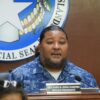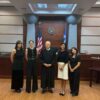THE Commonwealth Ports Authority board chair stands firm on their position that 100% of CPA’s utility costs paid by the Coronavirus Aid, Relief, and Economic Security Act or CARE funds “are attributable to airport operations.”
Responding to an annual audit indicating incompliance and discrepancies, CPA Board Chair Kimberlyn King-Hinds said CPA disagrees with the findings regarding “questionable cost.”
In an interview, King-Hinds said CPA will discuss this and other issues, including its ongoing dispute with Star Marianas Air, with the people of Saipan, Tinian and Rota through question & answer sessions.
The audit was conducted by Deloitte Touche LLP.
Findings
There were five findings in this year’s audit report, one of which questioned the $23,263 in CARES Act funds expended for utilities.
King-Hinds noted that the auditors used a formula that states that CPA could only reimburse 74 percent and not 100 percent of its utility costs from the CARES grant.
“CPA disagrees with this finding because it is CPA’s position that 100 percent of those utilities’ cost claimed are attributable to airport operations,” she said.
Another questioned cost was the $1,500 spent on plant rentals.
According to the audit report, CPA cannot use CARE funds for plant rentals because they are not directly related to the air transportation of passengers.
But King-Hinds said the CARES Act grant terms state that the funds “can be used for any purpose for which airport revenues may be used. The plant rental services are provided directly to the airport, and as such, CPA believes that it is an allowable cost.”
She said CPA has contacted the Federal Aviation Administration to confirm whether these costs are allowable under the grant and is waiting for further FAA guidance.
Other findings
As for the four other findings, the CPA chair said three have been corrected or are being corrected.
Finding No. 1 relates to expenses that were not recorded in the proper reporting period.
For example, the U.S. Army Corp of Engineers was contracted by the CNMI government to perform a harbor feasibility study for the Rota and Tinian ports in 2016.
She said CPA paid a part of the local share for that contract. However, the feasibility study, was not completed until 2018 and was not provided to CPA until 2021. As soon as the feasibility study was provided, King-Hinds said CPA recorded the expense.
But according to the audit report, this was an error and CPA should have recorded the expense in 2018, and not in 2021.
CPA did not contest this finding.
Finding No. 2 states that CPA did not follow certain procurement rules and regulations. For example, there were requests for proposal or RFPs that were advertised for less than the required bidding period of 30 days.
King-Hinds said CPA issued and advertised these questioned RFPs for a period of four weeks. But according to the audit, some of the advertisements were only for 28 days, falling short of the 30-days requirement.
The chair said the corrective measures that CPA has taken moving forward is to physically count the number of days instead of assuming that four weeks is sufficient.
Also under Finding No. 2, the audit report notes federal contracts that did not have a signature line for the procurement officer.
King-Hinds said, “We expect to see this as a repeat finding in next year’s audit because CPA has only been made aware of this oversight.”
She added, “CPA has taken corrective measures to address this issue by making sure that all future contracts have the required signature line for the procurement officer.”
Sole-source contracts
Regarding the sole-source contract for the roof replacement at the Francisco C. Ada/Saipan International Airport and the contract for the project management of the Aircraft Rescue and Firefighting training facility, King-Hinds said after Super Typhoon Yutu, CPA used its sole-source procurement process “to expeditiously complete the projects since the contractors were already familiar with the projects and facilities.”
She said the audit report included this finding because CPA did not state the unique capabilities of the contractors for the projects.
King-Hinds said “CPA is taking corrective measures by ensuring that all sole source contracts include the required justification, which was lacking in these two contracts.”
Finding No. 3 states that CPA is not in compliance with equipment and real property policies and regulations.
King-Hinds said resolving this issue is a work in progress because past accounting entries in CPA’s ledger lack specificity. This means that although an entry has been recorded, CPA is unable to identify what the asset is without additional research. For example, she said, CPA’s general asset ledger describes an asset from 1978 with an entry that states “TIQ FAA 75-0011-01.”
“We expect this to be a repeat finding in next year’s audit,” she added.
Other issues
The audit likewise stated that CPA did not record the fact that certain items were either damaged or disposed of. These included a tire and rim from 1997, computers from the 1990’s, and aluminum doors for the loading bridge, to name a few.
The chair said CPA agrees with this finding and CPA management is taking the necessary steps to identify these assets, properly record them, and ensure timely decommissioning and disposal of such non-functioning equipment.
Finding No. 4 pertains to discrepancies in CPA’s reporting of its local share for certain federally funded projects. Specifically, this finding is in regard to two grants: one for the loading bridges and one for the Saipan International Airport Master Plan. For the loading bridge grant, the audit report stated that CPA did not include the grant amendment when it calculated its share of the project cost.
King-Hinds said this has been corrected.
As for the Saipan International Airport Master Plan grant, she said CPA was required to submit a “close-out” report that lists all costs associated with the project.
She said that when CPA submitted this report, not all the costs associated with the project were included.
She said CPA agrees with these findings and has since revised the report to reflect all the costs that were associated with this project.
Transparency, accountability
In a statement, King-Hinds said:
“Audits are a great way of ensuring that CPA is transparent and accountable to the public as to the manner in which it expends public funds. More importantly, it is a great tool for board members to see where the gaps are in terms of policies and where management needs to improve with regard to operating procedures.
“I am confident that CPA’s management will implement the necessary corrective actions and measures to resolve the findings as raised by the audit. I would also like to announce that in furtherance of ensuring that the public understands what’s going on with the audit and the ongoing dispute with SMA, CPA will be conducting public hearings on all three islands. At these public hearings, CPA will present the findings of the audit, the ongoing dispute with SMA and answer any questions that the public may have as it relates to those issues. The time and venue of these public hearings will be announced in the near future.
“The annual audit is a tool that the CPA board uses to ensure that representations made by management in the course of spending funds, whether local or federal, are done so in compliance with applicable federal and local laws, rules, and regulations and in conformance with standards set by the Governmental Accounting Standards Board.
“When the audit issues findings, it tells the board that there’s room for improvement, and it is the board’s expectation that CPA management will swiftly take corrective measures to ensure that we are prudent managers of said funds and that we put in place internal controls, if lacking, to ensure compliance with all applicable laws, rules, and regulations.”












